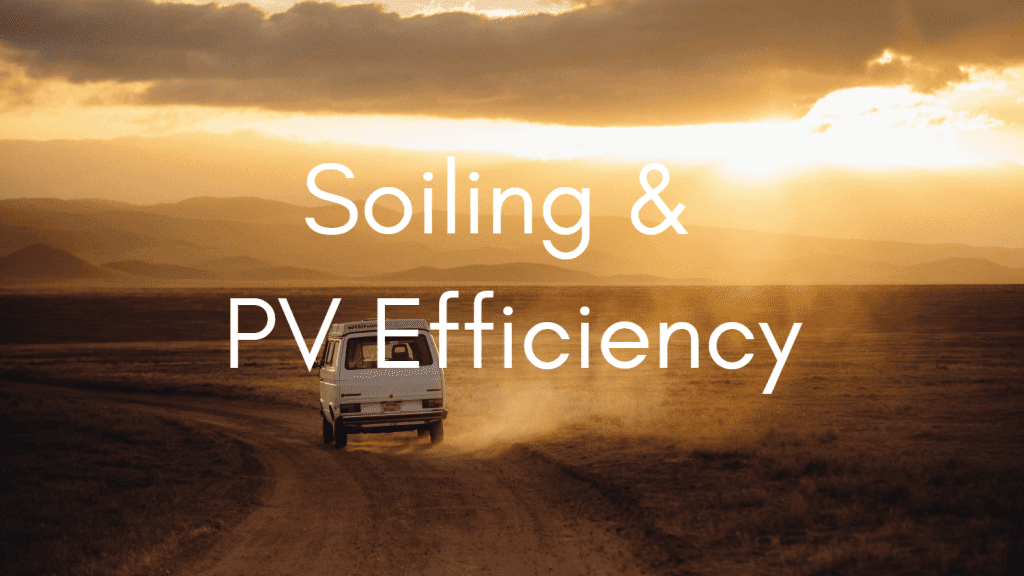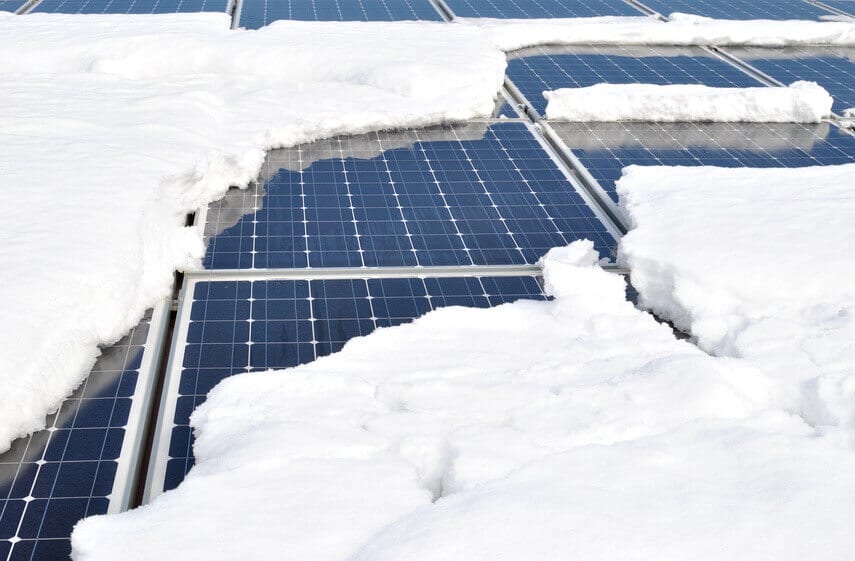PV soiling can significantly affect solar panel efficiency, and your bottom line.
By: Adam Baker
Why does soiling matter?
Soiling affects energy production, and energy production affects your bottom line. Every single PV site suffers from soiling. The question is: how much money can you lose before it matters?

Haboobs (dust storms) that blow into Arizona might cost a 300MW site $15,000 a day until the dust blows off or is washed off by rain. But if the site is making more than $200,000 a day, it’s probably not worth cleaning all those modules due to the extreme cost of washing 5 million modules.
Soiling is a tricky beast. Some solar owners don’t know why their site is making less energy, but figure because they reach maximum power each day, they have nothing to worry about.
They’re wrong.
The effects of PV soiling will not reduce your peak power. However, the width of your shoulder energy, and amount of time you’re in clipping will reduce. Tracking and taking care of soiling problems will not make more power, but it will make more energy on the sides of your energy production curve.

Some solar owners know their site is making less energy, but don’t know why. Unless you have the soiling monitoring in place that tells you how bad PV soiling is decreasing your solar panel efficiency, you won’t know when it makes financial sense to do something about it.
Let’s talk about crud.
Unfortunately, no solar farm can get away from soiling. Each type of crud has its own season. Depending on your geography, some are worse than others.
- Spring – Pollen
- Spring/Summer – Farm dust
- Fall – Leaves
- Winter – Snow
- Year-round – Bird droppings
Here’s how different crud types each affect solar panel efficiency.
 Bird droppings
Bird droppings
Season: Year-round
Size: Small, but persistent
Effect: A module is 2,800 square inches. If you lose a 2-square inch spot due to bird droppings, you lose .1% of the module’s output. 20 square inches means you’re losing 1%.
Removal: Bird droppings don’t evaporate or blow away. They remain until a heavy rainstorm (or many little rainstorms) wash them away.
If you have trees lining the property, birds tend to congregate. And where there are birds, there are droppings. Also, birds will congregate more if the site happens to fall on a migration route, and sometimes the birds congregate for no apparent reason.
One thing you may not realize is, the higher the tilt angle on a tracker site, the more birds want to sit on it. Trackers aimed at the rising sun are a bird’s favorite perch. Predatory birds like to perch on trackers in the morning and look for critters running around on the ground. (You’d be surprised at the size of hawk leavings.)
I’m thinking of one online site in particular that’s having a problem with its trackers. There are a couple droppings per square foot across thousands of modules, and (in addition to the fact that their trackers are broken) it is seriously affecting their output.
 Dirt/dust
Dirt/dust
Season: Year-round (especially worse in spring when farmers turn their fields)
Size: Blanketing, but (usually) thin
Effect: Because this is a year-round problem, it is the most common type of soiling
Removal: Similar to pollen, dirt isn’t particularly sticky. Any rain and even a bit of wind will help get it off modules. However, dirt from turning farm fields comes in very thick and may require multiple rainstorms. Haboobs also deposit thick dirt residue and there isn’t much rain to rely on in the desert for rinsing, so it is often fairly persistent.
Regular dust/dirt is an ongoing struggle at virtually every solar site due to the site’s access road. Every time they visit the site, O&M vehicles kick up dust that settles on the modules closest to the access road.
In addition, if the tilt angle of your fixed modules is very shallow, the frame has a small lip at the bottom that collects stuff (acorns, dirt, feathers, leaves). This residue builds up over time. Because it’s in a groove, it’s difficult to remove, but can wash off with a heavy rain.
 Pollen
Pollen
Season: Spring
Size: Blanketing, but thin
Effect: In areas with heavy foliage, pollen will form a thick blanket, affecting the entire site.
Removal: Pollen has a moderate effect because it can be dense, but isn’t sticky, though may persist longer than dust. Any rain will rinse it off. And because pollen occurs during the rainy season, it doesn’t stay for long.
Pollen deposits are obviously a type of soiling that more heavily affects the east coast. In general, there’s not much you can do about it, since it’s an ongoing part of the season, and can easily be washed off with rainstorms. You just have to grin and bear it.
 Leaves
Leaves
Season: Fall
Size: Varies, depending on tree species
Effect: There is more energy loss from leaves than from bird residue, because there are more leaves concentrated in one particular timeframe.
Removal: Similar to bird residue, leaves are difficult to remove. They get wet and stick to the module. Even after removal, they can leave a stain on the module.
Leaves are obviously a geographical soiling problem that plagues the south but doesn’t really occur in the west. If your solar site backs up to the edge of a moderate woods, there are many leaves that blow around. Luckily, they tend to stay at the perimeter of the site.
 Snow
Snow
Season: Winter.
Size: Blanketing and thick
Effect: An inch of snow will turn a module off. But it’s usually a short duration. On a site where snow affects production, it tends to be VERY dramatic, but recovers as soon as snow starts to melt. There is a geometric increase in module output as soon as the top edge of the module is exposed to the sun, and the production of energy starts to warm the module up. Production starts small, but recursively doubles until reaching normal output.
Removal: As you can see from the image, when the top of the module starts working, it gets warm. Once the melt starts, the snow slides off in sheets.
The good thing about sliding snow is, it takes all the dirt on the module when it slides down, and you end up with a cleaner module than you would have otherwise.
Miscellaneous
There are other types of soiling other than what I’ve outlined.
During the construction process, for example, a leak in a crane could spray hydraulic oil over the modules below it. I’ve actually seen this happen. It’s almost impossible to see, because the oil is transparent. But due to its sticky nature, it can cause quite a problem. Dirt will accumulate on those sticky spots and will remain for multiple years.
What can be done about PV soiling?
In most cases, soiling takes care of itself through rainstorms and wind storms. However, sometimes the effects of soiling become a negative impact on solar panel efficiency.
Here are some solutions to keep in mind to reduce PV soiling.
- Stay away from aftermarket module coatings. These are high cost with marginal benefit for utility-scale. Generally, if you have more than 50 modules it will cost you more than it will save you. Several module manufacturers are offering factory applied coatings, and I have seen better results with these solutions.
- During site design, remember that the flatter the modules, the more dirt will accumulate. When space is not a constraint on your land, steeper tilt angle is better.
- Work with your neighbors to reduce soiling. I have seen a site where 50-ft oak trees caused a shading and soiling nightmare for months at a time. The fed-up site owner offered to pay for the neighbor’s tree removal and replacement with medium-sized coniferous arborvitae shrubs. The neighbor was happy because he no longer had to look at the solar site, as the oak leaves were high above the line of site. The owner was happy because the lack of shading and leaf soiling paid for the cost of the shrubs in just two years.
Tracker-specific recommendations:
- Take preventative measures for snow. If it’s snowing at night, move trackers to the highest tilt angle. This helps snow slide off quicker in preparation for the morning.
- Take advantage of rain. Your site energy production is not great during rainstorms anyway, so position modules at a 20° tilt angle to get clean from rain.
- Install tracker technology that allows you to run a water truck through your site. A water truck using the access road can typically rinse off 10-15 modules in each direction. You may be able to get enough energy off the ends of the rows to justify the cost. Say you’re losing $500 a day from soiling and the forecast doesn’t estimate rain for another two weeks. If a water truck costs $3,000 and gives you back $300 in production, that service pays for itself in 10 days.
How do you know if soiling solutions are worth it?
Unfortunately, there’s not a lot you can do about PV soiling. But if you don’t have the data to tell you how soiling is affecting your asset, it is impossible to determine if changing tracker behavior or paying for a wash service is worth it.
Measuring soiling with an instrument is a very low cost in the big picture. What if you could quantify loss of energy due to X (farmer turning field, birds, leaves)? Then you could make some business decisions on if it makes sense to take corrective action.
We’d be happy to help you install a soiling monitoring system to better understand your losses from natural causes. They can be added to most sites for small incremental cost, and give you some basis in fact for justifying action to correct it.
Adam Baker
Adam Baker is Senior Sales Executive at Affinity Energy with responsibility for providing subject matter expertise in utility-scale solar plant controls, instrumentation, and data acquisition. With 23 years of experience in automation and control, Adam’s previous companies include Rockwell Automation (Allen-Bradley), First Solar, DEPCOM Power, and GE Fanuc Automation.
Adam was instrumental in the development and deployment of three of the largest PV solar power plants in the United States, including 550 MW Topaz Solar in California, 290 MW Agua Caliente Solar in Arizona, and 550 MW Desert Sunlight in the Mojave Desert.
After a 6-year stint in controls design and architecture for the PV solar market, Adam joined Affinity Energy in 2016 and returned to sales leadership, where he has spent most of his career. Adam has a B.S. in Electrical Engineering from the University of Massachusetts, and has been active in environmental and good food movements for several years.

